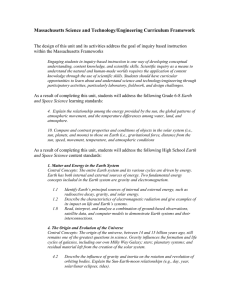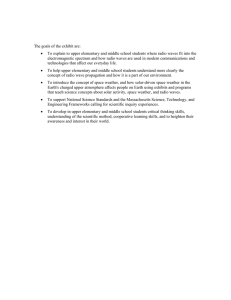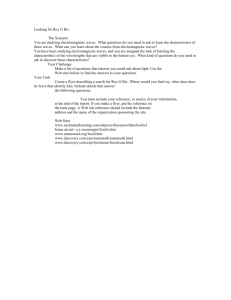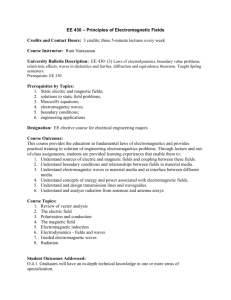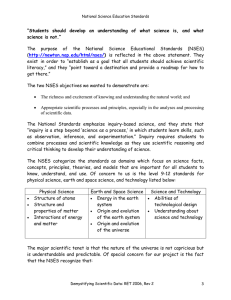The Massachusetts Science and Technology/Engineering High School Standards,
advertisement
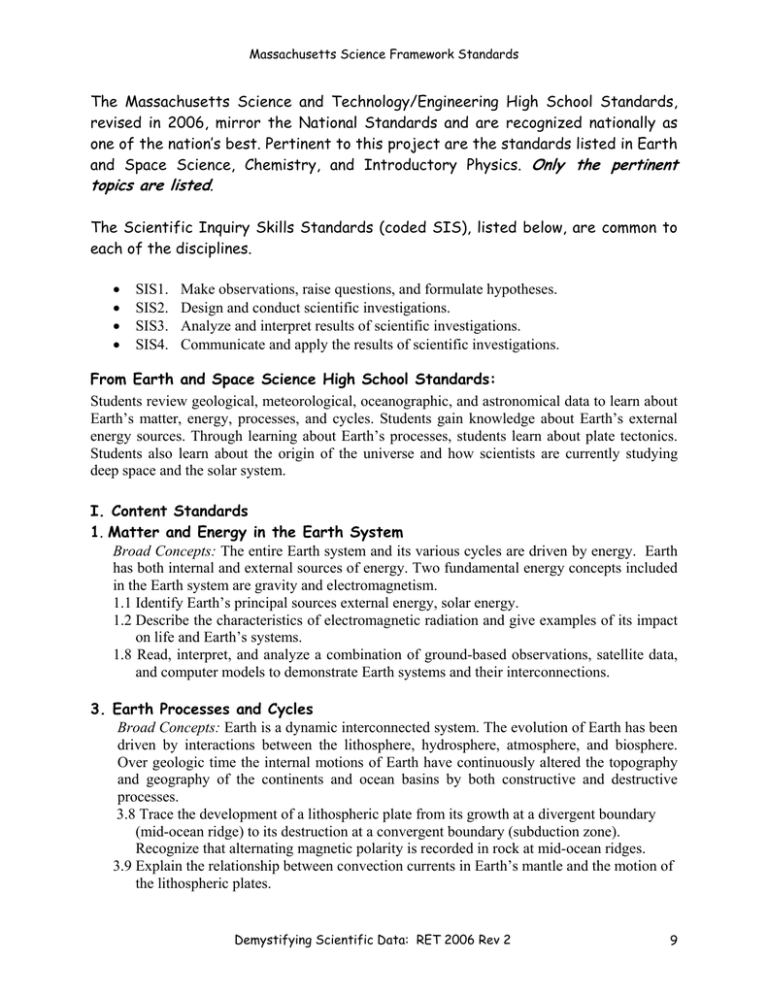
Massachusetts Science Framework Standards The Massachusetts Science and Technology/Engineering High School Standards, revised in 2006, mirror the National Standards and are recognized nationally as one of the nation’s best. Pertinent to this project are the standards listed in Earth and Space Science, Chemistry, and Introductory Physics. Only the pertinent topics are listed. The Scientific Inquiry Skills Standards (coded SIS), listed below, are common to each of the disciplines. • • • • SIS1. SIS2. SIS3. SIS4. Make observations, raise questions, and formulate hypotheses. Design and conduct scientific investigations. Analyze and interpret results of scientific investigations. Communicate and apply the results of scientific investigations. From Earth and Space Science High School Standards: Students review geological, meteorological, oceanographic, and astronomical data to learn about Earth’s matter, energy, processes, and cycles. Students gain knowledge about Earth’s external energy sources. Through learning about Earth’s processes, students learn about plate tectonics. Students also learn about the origin of the universe and how scientists are currently studying deep space and the solar system. I. Content Standards 1. Matter and Energy in the Earth System Broad Concepts: The entire Earth system and its various cycles are driven by energy. Earth has both internal and external sources of energy. Two fundamental energy concepts included in the Earth system are gravity and electromagnetism. 1.1 Identify Earth’s principal sources external energy, solar energy. 1.2 Describe the characteristics of electromagnetic radiation and give examples of its impact on life and Earth’s systems. 1.8 Read, interpret, and analyze a combination of ground-based observations, satellite data, and computer models to demonstrate Earth systems and their interconnections. 3. Earth Processes and Cycles Broad Concepts: Earth is a dynamic interconnected system. The evolution of Earth has been driven by interactions between the lithosphere, hydrosphere, atmosphere, and biosphere. Over geologic time the internal motions of Earth have continuously altered the topography and geography of the continents and ocean basins by both constructive and destructive processes. 3.8 Trace the development of a lithospheric plate from its growth at a divergent boundary (mid-ocean ridge) to its destruction at a convergent boundary (subduction zone). Recognize that alternating magnetic polarity is recorded in rock at mid-ocean ridges. 3.9 Explain the relationship between convection currents in Earth’s mantle and the motion of the lithospheric plates. Demystifying Scientific Data: RET 2006 Rev 2 9 Massachusetts Science Framework Standards 3.10 Relate earthquakes, volcanic activity, tsunamis, mountain building and tectonic uplift to plate movements. 4. The Origin and Evolution of the Universe Broad Concept: The origin of the universe. Gravity influences the formation and life cycles of galaxies, including our own Milky Way Galaxy, stars, planetary systems, and residual material left from the creation of the solar system. 4.1 Explain the Big Bang Theory and discuss the evidence that supports it, such as background radiation, and relativistic Doppler Effect ~ “red shift”. 4.2 Describe the influence of gravity and inertia on the rotation and revolution of orbiting bodies. 4.3 Explain how the sun, Earth, and solar system formed from a nebula of dust and gas in a spiral arm of the Milky Way Galaxy about 4.6 billion years ago. II. Scientific Inquiry Skills Standards Scientific literacy can be achieved by supporting students to inquire about geologic, meteorological, oceanographic, and astronomical phenomena. Scientific skills that are developed in Earth and Space Science include the inquiry skills presented below, as well as reading and interpreting maps, keys, and satellite, radar, and telescope imageries; using satellite and radar images and weather maps to illustrate weather forecasts; using data from various instruments that are used to study deep space and the solar system. The science curriculum should include substantial hands-on laboratory and field experiences. SIS1. Make observations, raise questions, and formulate hypotheses. Students will be able to: Pose questions and form hypotheses based on personal observations, scientific articles, experiments, and knowledge. Read, interpret, and examine the credibility and validity of scientific claims in different sources of information, such as scientific articles, advertisements, or media stories. SIS2. Design and conduct scientific investigations. Students will be able to: Articulate and explain the major concepts being investigated and the purpose of an investigation. Employ appropriate methods for accurately and consistently o making observations; o making and recording measurements at an appropriate level of precision and; o collecting data or evidence in an organized way. Properly use instruments, equipment, and materials (such as scales, probeware, meter sticks, microscopes, computers, etc.) including: set-up, calibration (if required), technique, maintenance, and storage. Demystifying Scientific Data: RET 2006 Rev 2 10 Massachusetts Science Framework Standards SIS3. Analyze and interpret results of scientific investigations. Students will be able to: Present relationships between variables in appropriate forms. o Represent data and relationships between variables in charts and graphs. o Use appropriate technology (such as graphing software, etc.) and other tools. Use mathematical operations to analyze and interpret data results. Identify reasons for inconsistent results, such as sources of error or uncontrolled conditions, and assess the reliability of data. Use results of an experiment to develop a conclusion to an investigation that addresses the initial questions and supports or refutes the stated hypothesis. State questions raised by an experiment that may require further investigation. SIS4. Communicate and apply the results of scientific investigations. Students will be able to: Review information, explain statistical analysis, and summarize data collected and analyzed from an investigation. Explain diagrams and charts that represent relationships of variables. Use and refine scientific models that simulate physical processes or phenomena. III. Mathematical Skills Some specific skills from the Mathematics Framework that students in this course should have the opportunity to apply: • Construct and use tables and graphs to interpret data sets. • Perform basic statistical procedures to analyze the center and spread of data. Although not detailed in the Mathematics Framework, understanding and knowledge of percent error from experimental and accepted values are important. Introductory Physics 4. Waves Broad Concept: Waves carry energy from place to place without the transfer of matter. 4.1 Describe the apparent change in frequency of waves due to the motion of a source or a receiver (the Doppler Effect). 6. Electromagnetic Radiation Broad Concept: Oscillating electric or magnetic fields generate electromagnetic waves over a wide spectrum. 6.1 Recognize that electromagnetic waves are transverse waves and travel at the speed of light through a vacuum. 6.2 Describe the electromagnetic spectrum in terms of frequency and wavelength and identify the regions of radio waves, microwaves, infrared radiation, visible light, ultraviolet rays, x-rays, and gamma rays on the spectrum. Demystifying Scientific Data: RET 2006 Rev 2 11 Massachusetts Science Framework Standards Demystifying Scientific Data: RET 2006 Rev 2 12
